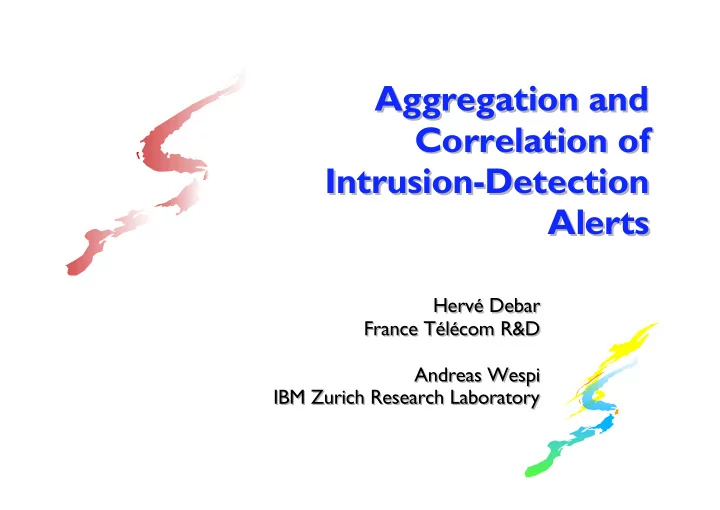

Aggregation and Aggregation and Correlation of Correlation of Intrusion-Detection Intrusion-Detection Alerts Alerts Hervé Debar Hervé Debar France Télécom R&D France Télécom R&D Andreas Wespi Andreas Wespi IBM Zurich Research Laboratory IBM Zurich Research Laboratory
Overview Overview Introduction Architecture Representation of alerts Aggregation and correlation of alerts Future work
Issues addressed Issues addressed Aggregation and correlation of ID alerts generated by a diversity of sensors Flooding: operator gets overloaded by the large number of ID alerts Context: grouping of related alerts Elimination of false alerts Scalability
What's special about our project? What's special about our project? Started about 3 years ago Influenced the IDWG work on IDMEF Reused existing framework to integrate the ID sensors and their alerts: Tivoli Enterprise Console Is available as a product: Tivoli Risk Manager
Overview Overview Introduction Architecture Representation of alerts Aggregation and correlation of alerts Future work
Architecture Architecture Alert emission Report emission Aggregation & Report generation Diagnostic Correlation Alert accumulation Alert analysis (TEC) Alert acquisition Aggregation & Aggregation & Probe Correlation Correlation (WebIDS) (TEC) (TEC) Alert emission Diagnostic Probe Probe Probe Data analysis (ISS RealSecure) (Cisco Secure IDS) (ISS RealSecure) Data formatting Data acquisition
Tivoli Enterprise Console Tivoli Enterprise Console TEC_tasks e Alert reaction l o s n o Alert display TEC_display C TEC_rules e s Alert correlation i r p r e t n TEC_reception E i l Alert reception o v i T Pre-adapter Pre-adapter (ISS RealSecure) (Cisco Secure IDS) Probe Probe Probe (ISS RealSecure) (WebIDS) (Cisco Secure IDS)
Overview Overview Introduction A generic, scalable ID Architecture Representation of alerts Aggregation and correlation of alerts Future work
Alert class hierarchy (1) Alert class hierarchy (1) Data-driven approach represent in a structured way all information as provided by the probes use same data structure for all types of probes (host- and network-based, knowledge- and behavior-based, ...) Unified data model: independence of the correlation algorithms and the actual alerts generated by the probes easy integration of any probe in the correlation framework
Alert class hierarchy (2) Alert class hierarchy (2) Data model corresponds to an early draft of the IDWG proposal for a standard message exchange format Abstract classes: generic part of alerts Implementation classes: inherit from abstract classes carry specific alert information generated by specific probes
Layered data model Layered data model ID Probe ID Alert product time Sensor layer hostname name IP address severity confidence Target layer Multiple Hosts Single Hosts Number of hosts Dest IP Spoofed Origin Real Origin Source layer Spoofed Src IP Src IP TCP/UDP ICMP Detailed target Src Port Code Dest Port Type layer HTTP SNMP URL Community
Overview Overview Introduction Architecture Representation of alerts Aggregation and correlation Conclusions and future work
Alert prepocessing Alert prepocessing Purpose: error checking unify information provided by different probes IP address (network-based IDS) vs. hostname (host-based IDS) Port number (network-based IDS) vs. service name (host-based IDS) Validity of timestamp is checked and adjusted if needed
Duplicates (1) Duplicates (1) Different sensors see the same attack, e.g.: duplicate_event('NR_WWW_bat_File', 'RS_HTTP_IE_BAT', [source, dest, url, time], 4.0). If source, dest, and url of the two events are the same and the timestamps are close, the two events are linked and further on treated as a single event.
Duplicates (2) Duplicates (2) Two events by the same sensor are related, e.g.: duplicate_event('WW_Suspicious_Cgi', 'WW_Success', [ids, req_id], 25.0). Duplicate gets a high severity value due to a successful cgi attack.
Consequences Consequences A consequence chain is a set of alerts linked in a given order, where the link must occur within a given time interval, e.g.: consequence('RS_Http_Phf, 'rs.probe.org', 'WW_InsecCgiPhf', 'web.probe.org', 30, 10.0). If the WebIDS probe does not report the phf attack within 30 seconds, an internal event is generated with severity 10.0 This feature may be used to check whether a probe is still operational.
Situations (1) Situations (1) Single alerts may not be significant, but the aggregation of single alerts may reveal the attack. A situation is a set of alerts that have certain characteristics in common Three aggregation axes: source, target, and attack category Systematic combination of aggregation axes results in seven situations
Situations (2) Situations (2) 1 attack/source/dest attack source dest 2-1 attack/source attack source * 2-2 attack/dest attack * dest 2-3 source/dest * source dest 3-1 attack attack * * 3-2 source * source * 3-3 dest * * dest
Situations (3) Situations (3) Situations are evaluated in parallel. Thresholds for different warning levels have to be specified, e.g. threshold('situation1',warning,minor,critical,source,dest,attack). Generic as well as specific situations, e.g.: threshold('situation1', 10.0, 20.0, 30.0, _, _, _). threshold('situation1', 5.0, 10.0, 20.0, 'susp.host.org, _, _). Different sizes of time windows are considered.
Overview Overview Introduction Architecture Representation of alerts Correlation and aggregation Future work
Future work Future work Improved correlation rules Analysis of real data Robust correlation rules Improved performance by outsourcing certain correlation rules from TEC's prolog engine Zurich correlation engine Consider information about network topology and machine configurations Integration of new sensors
Operational issues Operational issues Configuration Severity and confidence value per alert Default vs. site-specific values Performance One alert per second
Conclusions Conclusions Correlation is needed to reduce the number of alerts a system administrator has to handle. A standard message format will help to easily integrate new sensors in our framework.
Recommend
More recommend